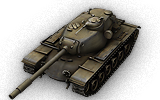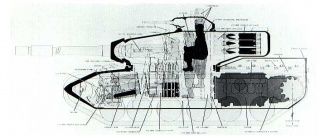T110E5
T110 (Stock)
| 6100000 Cena |
| 2000 HPVýdrž |
| 53.76 / 60.05 Hmotnost |
- Velitel
- Radista
- Střelec
- Řidič
- Nabíječ
| 254/76/38Pancíř korby(čelní/boční/zadní, mm) |
| 203/127/70Pancíř věže(čelní/boční/zadní, mm) |
| 875 hpVýkon motoru |
| 37 km/hMax. rychlost / couvání |
| 25 stupňů/sRychlost otáčení |
| 400 damage |
| 258 mmPrůměrná průbojnost |
| 10 Doba úplného nabití |
| 20 stupňů/sRychlost nastavení odměru |
| 250 mDohled |
| 500 mDosah rádia |

The T110E5 is an American tier 10 heavy tank.
This tank has high penetration and relatively quick reload in exchange for a lower single-shot damage compared to many traditional heavy tanks. The T110E5 is a relatively quick heavy with good gun handling characteristics and alternating strong/weak armor zones, allowing it to force other tanks to react its actions when driven well. The T110 is something of a blend of heavy and medium characteristics, allowing it to fill almost any role on the field and perform well, but making it less specialized for specific roles compared to many other tier X tanks.
The T110E5 retains the 'eggshell' style of front hull armor layout from the M103 and has greater protection in the areas of high thickness both in the hull and the turret. There is little increase in effective protection in the previously thin areas such as the lower plate however. The T110E5 also has a prominent commander's coupla that invites shells from opposing players. However, such an obvious target can be a boon as much as a liability in the hands of a player familiar with baiting and misdirecting coupla shots by opponents; the coupla is more heavily armored than most US couplas and can surprise many an opponent looking for a quick shot.
The T110E5 marks the end of its American heavy line.


Věž
| Úroveň | Věž | Pancíř věže (čelní/boční/zadní, mm) | Rychlost nastavení odměru (stupňů/s) | Dohled (m) | Zkušenosti | Hmotnost (t) |
|---|---|---|---|---|---|---|
| X | T53 | 203/127/70 | 20 | 250 | 0 | 11000 |
| Úroveň | Dělo | Průměrná průbojnost (mm) | Rychlost palby | Rozptyl na 100 m | Čas zaměření | Zkušenosti | Hmotnost (t) | |
|---|---|---|---|---|---|---|---|---|
| X | 120 mm Gun M58 | 258/340/60 | 400/400/515 | 6 | 0.35 | 2 | 0 | 3100 |

Motor
| Úroveň | Motor | Výkon motoru (hp) | Pravděpodobnost požáru při zásahu | Zkušenosti | Hmotnost (t) |
|---|---|---|---|---|---|
| X | Continental AOI-1490 | 875 | 20 | 0 | 1200 |

| Úroveň | Podvozek | Maximální nosnost | Rychlost otáčení (stupňů/s) | Zkušenosti | Hmotnost (t) |
|---|---|---|---|---|---|
| X | T110E27 | 60.05 | 25 | 0 | 8000 |

Rádio
| Úroveň | Rádio | Dosah rádia (m) | Zkušenosti | Hmotnost (t) |
|---|---|---|---|---|
| X | AN_VRC-3 | 500 | 0 | 160 |
Compatible Equipment
Compatible Consumables
Player Opinion
Pros and Cons
Pros:
- Does not sacrifice mobility for protection by using armor hardpoints rather than large areas of armor
- Excellent overall gun handling
- Agile compared to other heavy tanks
- Good damage output: decent but not stellar RoF with acceptable alpha
- The cupola on the turret is well rounded and armored and can bounce shells on longer distance very easily
Cons:
- Side and rear armor weak against shots aimed directly at their faces
- Large ammo rack hitboxes are normally found behind the weakest armor segments in the front and sides
- Large cupola
Performance
With respectable frontal armor and an excellent gun, the combination of mobility, protection and firepower makes the T110E5 possibly the most versatile tank in the game. As is with its predecessor, the E5 is best used as a second line support tank as its weak spots become very easy to hit once up close, however it is more than capable of holding its ground in a brawl in the hands of a skilled player that understands and utilizes angling and distraction techniques.
Historical Info
Design and Development
The original project of T110 was rejected by the military because of its excessive size (it wouldn’t fit in the standard tunnel) and a poorly allocated commander tower, placed on the left. The company suggested another variant – the tower was placed at the center of the body, but, to solve the issue with fitting in the transmission, the driver-mechanic’s place was placed in the combat compartment. The latter was also ill received by the military and the driver’s was returned to the original place. When endorsing the project with the Detroit tank arsenal, the drive layout was decided to be remade into rear-wheeled. Now it was necessary to remove the commander tower altogether to keep the size in check. In addition, according to the order, instead of the AV-1790 engine, they had to use an air-cooled AOI-1490 with the power of 700 HP and the same XTG-500 transmission. The 120-mm T123E1 gun was placed on solid setting. Now there appeared problems with the power unit: it was out of reach. It was decided to make the engine “roll out” on the rails through a large manhole in the body’s rear. But a manhole like that drastically lowered the body’s rigidity.
After all these troubles, Chrysler came up with the fourth variant of the tank. Now the AOI1490 engine and XTG-510 transmission were placed in the rear compartment of the tank, in a classic manner. The length of the body increased, but it would solve most of the problems with the power unit. The 120-mm gun was placed solidly in the mask, providing horizontal firing angles of 15 degrees to the sides and inclination angles of +20 degrees and -10 degrees. Constructing the cannon’s mask proved problematic. It has to be 230mm thick and weigh just under two tons. The body’s forehead sheet and the cabin defense was equal to a 127-mm sheet angled at 60 degrees. The support weapons included a 7,62mm machinegun, that was paired with the cannon and a 12,7-mm machinegun located in the commander tower. The telescopic sight T156 were used for shooting. M16A1 periscopic sight was used as a back-up. The tank commander was able to use the T53 “OPTAR” rangefinder, installed on the top of the cabin. “OPTAR” was an optical rangefinder, used to evaluate the range covered by light impulses. Needless to say that this device, preceding the laser technology, wasn’t very effective and suffered from light dazzles.
The driver’s place was placed in the left side – near the gun. With such driver and gunner placement, the forehead armor had to be made with a lesser angle, so it was required to make it much thicker. This was the main downside of utilizing an immovable cabin instead of a tower.
The next logical step – replacing the cabin with a tower, that was possible while staying in the planned 50-ton limits of the machine. As the result, a classically composed tank was made, in which were utilized many of the already existing units, that was able to be built fairly quickly and cheaply. This tank became the fifth Chrysler’s project. The 120-mm gun was solidly fastened to the tower mask, having the standard 2,15-m epaulet like in the M103 heavy tank. The main difference from the standard composition became the placement of the gunner and the commander to the left of the gun. The team was reduced to four people – one of the loaders was excluded, replaced by a mechanical loader. The “OPTAR” T53 rangefinder was installed on the left side of the tower and could be used by both the gunner and the commander of the tank. Compared to the tower-less variant, the new T110 was providing better firing ability and quicker target hitting. The project had made it to the final stange – it was constructed and shown to the specialists of the Detroit arsenal in the form of a full-sized tank model. However, by that time, the modification project of T43-T43E2 heavy tank was successfully accepted, and that, together with the decision to concentrate the attention on lighter tanks, lead to the end of all works on T110.
Historical Gallery
Sources and External Links
| Light Tanks | |
| Medium Tanks | |
| Heavy Tanks | |
| Tank Destroyers | |
| Self-Propelled Artillery |
| USA | |
| UK | |
| Germany | |
| USSR | |
| China | |
| Japan |

